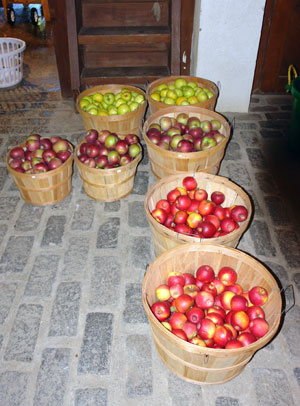

The property next to the one where I grew up was a rambling old North Shore estate that had already been carved up several times. There was an old wooden barn with a storm cellar and a tool shed with all kinds of farm and orchard tools that predated gasoline engines. There was the infamous compost pile that I once set ablaze (by accident) and a magnificent vineyard whose fall ripening fruit sent an intoxicating sweet scent through the neighborhood for weeks on end. There was a cherry tree that seemed 100 feet tall, several types of pear and peaches and an apple orchard with maybe 40 large fruiting trees.
First, the cherries would come into season and we’d pick them by the bucket (or so it now seems) with most of the berries being eaten before they got anywhere near a pie. Later came the huge peaches, sickle pears, grapes and all the while from late summer through hard frost the apples seemed to drop from heaven and those that refused to drop at exactly the right moment were coaxed with large wire apple pickers at the end of long poles.
There was always a wafting aroma from this fruitland as we could only eat and give away so much. The landowners never seemed to care much about this gold mine, but as they got older they looked forward more to the annual flood of neighborhood children than the harvest.
The yellow jackets and crows always had a field day, but it was a rare day that you could come through the orchard and find a fallen apple left behind. Nearly every pome that fell or could be reached that didn’t end up eaten, or pied, no matter how scarred or blemished, made its way to the ancient, but serviceable apple press, thence to cider.
You don’t run into many people these days who are making their own cider and it’s too bad. The stuff sold in supermarkets is about as bogus as you can get (usually highly filtered and heat pasteurized) and it probably resembles the real thing only in a legal definition, not taste or quality.
For a short period of time in the fall you can purchase good cider that is locally produced and at a handful of local spots local apples are used as well.
Making your own cider can be a perfect solution to more apples in your backyard than you can eat and the way an apple looks has little to do with the way the cider tastes, so nearly every apple can go into the mash.
According to a 1905 edition of Garden Magazine, the best cider is not made of sweet apples, but from good, juicy sour kinds such as Northern Spy and Baldwin, both of which are still available. It’s often advisable, however, to put in a portion of sweet apples, according to your particular tastes. And just to confuse matters, there are some texts that say you should use only one type of apple per cider batch using the other varieties as fill-ins only when the crop falls short.
Back at the turn of the 20th century, an apple press went for $10 and you could buy them at Sears. For years, presses were hard to find, but now all you have to do is Google “apple press” and you’ll find a half dozen vendors selling presses from $300 to more than $800. Some are quite simple and adequate for a small home orchard while others can be used by two people to press six to 10 gallons an hour.
A bushel of apples should yield from 2 to as much as 4 gallons of cider, but this varies depending on the type of apples being pressed. Some other interesting facts: fresh made, chilled cider will remain stable in the refrigerator for as long as three weeks, but plan on two. In Vermont, the main apples used for cider are McIntosh. Cider can be frozen without any loss in quality for about a year by filling 1-gallon plastic jugs (very clean ones, please) 80 percent with cider to allow for expansion during freezing.
The old-fashioned method (and yes, there are newer and easier methods) of preparation calls for the making of a pomace first. On a layer of straw (preferably rye straw), the crushed and ground apples are placed inside the press layer upon layer until the press is filled. This layered “cheese” is then pressed for the first time, the pressure released and the cheese is stirred, then the pressure is applied again. The raw, unfiltered cider is then placed in casks that are left uncorked for several weeks to “work” and then the cask is corked. If the cask is kept airtight from the time the cider is made it might last through the winter, but it gets harder and harder. With the cask uncorked, you’ll end up with some excellent apple cider vinegar.
Now, this is all well and good, but we just use a grinder and a press. We store, or sweat, the apples in a cold cellar for about a week, then all the bushels are brought to a wash room where the pressing is done. The apples, or mixes of apples, go into a tub where they are washed and then two people begin the grinding. One person feeds the apples into the grinder while the other turns the wheel. It’s a great physical workout for a cool fall morning. The result is a mash that falls into a wooden slatted bucket below that is lined with a nylon mesh bag. When the bucket is full, it’s moved down the plank about 18 inches until it’s under the press and an empty bucket is put in its place. A wooden lid is placed on the top of the mash bucket then one person turns the screw on the press, putting pressure on the lid, and slowly, ever so slowly, the cider is squeezed from the mash as it flows through the nylon filter bag then out the slats of the wooden bucket. It flows down a channel to the end of the press where it drops into a funnel and then into a waiting pail.
When one pail is full it’s decanted into gallon and half gallon jugs. We try to label each jug to indicate what the apple mix was for that particular batch and date the jugs. When all the jugs are filled, about 90 percent of them go to the freezer.
Since we don’t pasteurize our cider, we never use drops, or apples that have hit the ground, as this vastly reduces any chance of bacterial contamination. In years when our crop isn’t so great, we know of other growers who will sell us their seconds or utility apples, but this makes me a little nervous as I don’t know where they’ve been and how clean they are.
Sanitation is critical and during the whole process you want to make sure that your hands are clean as are all the parts of the press. We wash everything with hot water and dish soap before pressing and after and we always wash the apples before pressing as well.
Now, there is a different type of cider than the one we are most familiar with (actually there are several types of hard and soft cider). I discovered this while on my first trip to the Chelsea Flower Show in London. My hosts were the Blooms of Bressingham Gardens and I was spending the day with one of their managers as they set up their displays for the show. In mid-afternoon he suggested we go across the street to get a glass of cider. The brew was absolutely wonderful, sweet and most definitely made from apples. A half hour later we headed back to the show but as I stood to leave the pub I realized that the cider had gotten me pleasantly smashed.
If you’d like more information on cider, cider making and the wonderful fermented English cider, simply Google “apple cider” and you can read to your heart’s content.
The press that we use was purchased from Happy Valley Ranch (happyvalleyranch.com) in Kansas about eight years ago and they still sell the same model, the American Harvester, which now goes for $770, but they do have smaller and less expensive ones. First though, you need the apples, so get your orchard cranking or stop by one of the local orchards on the North or South fork and see if you can strike a deal for pressing apples for next year.
There’s also a great book on cider, “Cider Hard and Sweet, History, Traditions and Making Your Own” by Ben Watson (new edition just released) that would make a great gift or reference.
In the meantime, keep growing.
Andrew Messinger has been a professional horticulturist for more than 30 years. He divides his time between homes and gardens in Southampton, Westchester and the Catskills. E-mail him at: Andrew@hamptongardener.com. The Hampton Gardener is a registered trademark.
 More Posts from Andrew Messinger
More Posts from Andrew Messinger